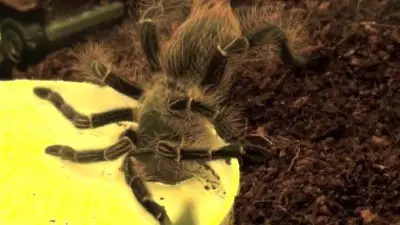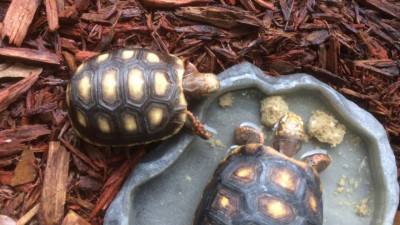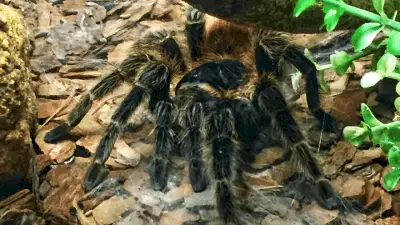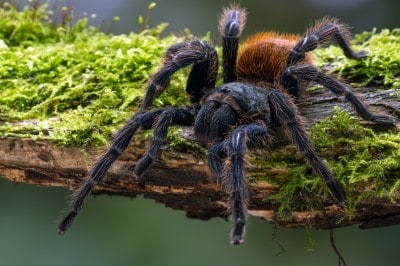Why is my tarantula putting dirt in his water? This is a common question most first time owners of tarantulas ask.
It is a behavior frequently observed in tarantulas in captivity. So, what causes this behavior? Let’s find out.
Tarantulas don’t like to get wet. Some owners believe that putting dirt in the water dish is because the tarantula doesn’t like standing water.
If you put its water dish near the opening of his burrow, some owners believe this appears to cause the behavior of putting dirt in the water to avoid having the burrow flood.
But, the truth is no one knows the answer. There are some owners who think it is intentional and some feel it is accidental.
The owners feel it is accidental as the tarantula is doing construction on their burrows. And then, some have viewed their tarantulas purposefully filling the dish with dirt or substrate.

Why is My Tarantula Putting Dirt in His Water?
While the reason is unknown, some tarantulas do act this way. Some bury their uneaten food or carcasses in the water and then throw the substrate over it.
There are few additional reasons some tarantula experts believe these arachnids put dirt in their water:
- Some believe this is a way to keep their burrow tidy and clean.
- Some believe it is because in the wild, tarantulas use moving water, like a stream, to take away their waste and other materials to keep their burrow neat.
- Some believe the tarantula uses the dirt in the water to adjust the humidity in the enclosure.
One particular owner believed his tarantula knew the humidity was too high and filled the water dish due to this.
He theorized that the tarantula was adjusting to captivity and because it couldn’t leave the area, like it would in the wild, it covered the water in an attempt to fix it.
Humidity is important to tarantulas and so this could explain the behavior. You should be sure that your ventilation holes are large enough and the substrate is moist to keep the humidity at the appropriate level.
But you don’t want the substrate to be too moist because it can cause mold, mites and bacteria. The behavior could be related to the humidity.
But does this explain the unusual behavior? Again, it is supposition. No one truly knows. All the owner can do is keep the tarantula healthy, clean up after it, and appreciate their pet.
This behavior frustrates some owners because the owner perceives the substrate needs to be cleaned up right away.
But, tarantulas can obtain moisture through their food as well as the substrate. So leaving the water dish with a substrate in it for a day will not hurt the tarantula.
Do Arboreal Tarantulas Behave This Way Too?
The simple answer is yes. But arboreal tarantulas seem to have a specific reason for this behavior.
Arboreal tarantulas like to be hidden high up in the trees. Some will actually use the substrate mixed with the water to make mud cakes. Then the arboreal tarantula will use it as camouflage for its hiding place.
It is believed this will keep predators away. Arboreal tarantulas have been seen dragging all types of materials up to their nest to do this too.
They will bring moss, parts of cork bark and leaves to establish their nest as waterproof and hidden.
It doesn’t appear related to a specific species either. Some owners feel this behavior is natural. But the behavior can be observed in both terrestrial and arboreal tarantulas.
Could This Be a Protective Measure?
It has been observed that before a heavy rain, tarantulas will close up the entrance to their burrow.
It is believed to be a protective measure to prevent the burrow from flooding. But again, no one knows and it’s merely speculation on the part of the owner.
Could this be the same type of behavior? Just like burrowing, it may be an inherent behavior. Tarantulas are peculiar animals.
It takes a significant amount of time to learn all the tarantula’s behaviors for new tarantula owners.
And because there are so many species, behaviors vary among them. Each tarantula has a personality of its own.
While some species are aggressive, some are passive. Tarantulas are classified in many ways as well.
Old World Vs. New World Tarantulas
So, what is the difference between Old World and New World tarantulas. Many people think the Old World means the tarantula is a species that is older, while the New World means the tarantula is a newer species.
But this is incorrect. Actually, the Old World and New World relates to where the tarantula comes from.
Old World tarantulas are from Asia, Africa, Europe and places populated before the Americas were discovered. New World tarantulas come from North, Central and South America.
Old World tarantulas tend to be much more aggressive, faster and amenable to being handled. New World tarantulas are docile, slower and some can be handled.
But even these differences don’t explain why tarantulas of different species have the same behavior.
There is no obvious answer. All owners would like to know the specific answer. They want to understand it to attempt to mitigate the behavior. So, what can an owner do to stop this behavior?
Read more about Old World vs New World Tarantulas, What’s the Difference?
Are There Options to Resolve This Behavior?
There are some owners who accept this behavior as natural, and they adapt to it. They clean out the water dish and replace it often.
Some tarantulas will even burrow under the water dish and then cover it with the substrate. It is believed this behavior is related to putting dirt in the water dish.
Some owners move the water dish to any area far away from the tarantula and have found some success.
Others merely place two water dishes in the enclosure, so the tarantula can bury one and drink out of the other dish. So, who should adapt? Should it be the tarantula or the owner?
Tarantulas in captivity have difficulty changing and adapting to the new environment already. The only one who can change is the owner.
As the dedicated care provider to the tarantula, the owner should do what is in the best interest of the tarantula.
Although knowing what causes the behavior would be helpful, it currently doesn’t appear an option.
The Outcome
As you can see, it’s difficult to pinpoint one singular answer to the question “why is my tarantula putting dirt in his water?”.
Maybe it’s related to the humidity. It could be related to preventing the burrow from flooding. It may be that the tarantula wants to get rid of waste and keep the burrow clean. And, it may even be about burrowing too.
Additionally, the behavior could be related to captivity, while some experts believe it is related to reconstruction of the burrow.
Could it be intentional or was it accidental? Is it related to the type of tarantula or where the tarantula came from? No one may ever know.
As the owner, you know about the behavior of your tarantula. You can keep an eye on your pet and use trial and error to determine if there is something wrong or if the behavior is a natural behavior by your tarantula.
The tarantula may want to clean his house and this is how he accomplishes it. As owners, you have to roll with it. And take the time to enjoy your pet tarantula.








